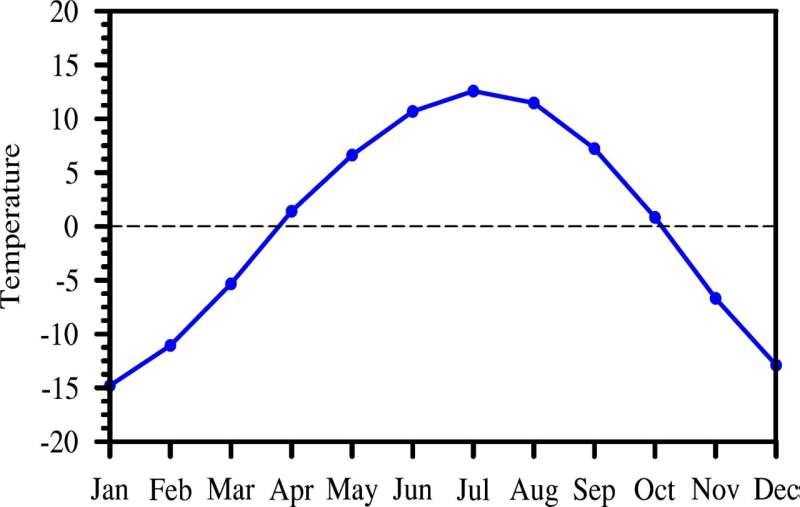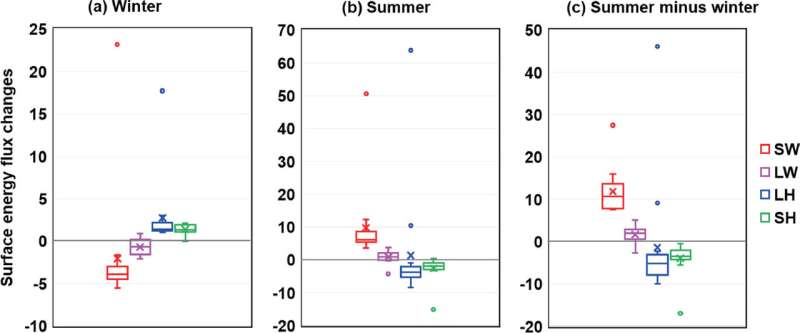This article has been reviewed according to Science X's editorial process and policies. Editors have highlighted the following attributes while ensuring the content's credibility:
fact-checked
trusted source
proofread
Insights from past warming: Enhanced temperature seasonality in China during the mid-Holocene

Against the background of global warming, the temperature seasonality has changed obviously at global and regional scales, which has exerted significant ecological and societal impacts. As a populous country highly sensitive to climate change, China experienced an overall decreasing trend of the amplitude of the annual temperature cycle during 1961–2007.
This national-scale average downward trend is likely to continue throughout the rest of the 21st century according to future projections, with a spatially robust decrease in most regions but increases at more local scales. However, the reasons for the observed and projected changes in temperature seasonality remain inconclusive, especially at the regional scale.
In this regard, it is necessary to look back into the past to better understand the change in temperature seasonality under different climate backgrounds and the associated physical mechanisms, particularly at the regional scale.
The mid-Holocene, about 6,000 years ago, was an interglacial period with an estimated global mean warming of approximately 0.2°C–1.0°C relative to 1850–1900. It has also been used as one of the benchmark periods for paleoclimate simulations under the framework of the Paleoclimate Modeling Intercomparison Project (PMIP) within the Coupled Model Intercomparison Project (CMIP).
The Earth's orbital parameters underwent remarkable changes during the mid-Holocene, resulting in an increase (decrease) of the seasonal distribution of insolation in the Northern (Southern) Hemisphere by about 5%, and thus an overall enhanced seasonality of surface air temperature in the Northern Hemisphere. Hitherto, whether this was the case for all northern latitudes, especially for extratropical China, remains unclear.

Towards addressing this knowledge gap, Associate Prof. Zhiping Tian and Prof. Dabang Jiang from the Institute of Atmospheric Physics, Chinese Academy of Sciences, quantified the temperature seasonality change in China during the mid-Holocene and the associated mechanisms using all available simulations performed by 16 models from CMIP6/PMIP4. The results have recently been published in Atmospheric and Oceanic Science Letters.
According to this study, all 16 models consistently showed an enhanced temperature seasonality (i.e., summer minus winter surface air temperature) across China during the mid-Holocene relative to the preindustrial period, with a nationally averaged enhancement of 2.44°C or 9% for the multimodel mean.
The temperature seasonality change was closely related with the seasonal contrast variation of surface energy fluxes, mainly due to the mid-Holocene orbital forcing, with a dominant role played by net shortwave radiation, a minor contribution from net longwave radiation, and partial offset effects from sensible and latent heat fluxes. Besides, based on proxy data that can reflect seasonal signals, there are uncertainties in the reconstructed temperature seasonality over China during the mid-Holocene.
"Notably, these insights from past warming period are contrary to the overall reduced amplitude of the seasonal temperature cycle over China under future global warming scenarios, which can mainly be attributed to the latent heat flux changes," explains the corresponding author of the study, Associate Prof. Tian. "Therefore, this study highlights that changes in the amplitude of temperature seasonality and associated physical mechanisms are related to the background climate states with specific forcing."
More information: Zhiping Tian et al, Enhanced seasonality of surface air temperature over China during the mid-Holocene, Atmospheric and Oceanic Science Letters (2023). DOI: 10.1016/j.aosl.2023.100393
Provided by Chinese Academy of Sciences



















